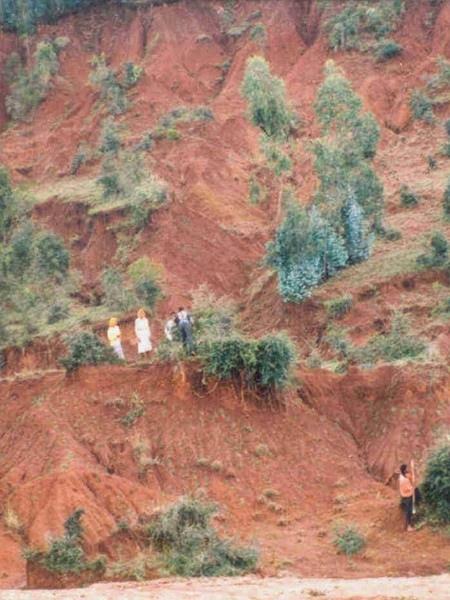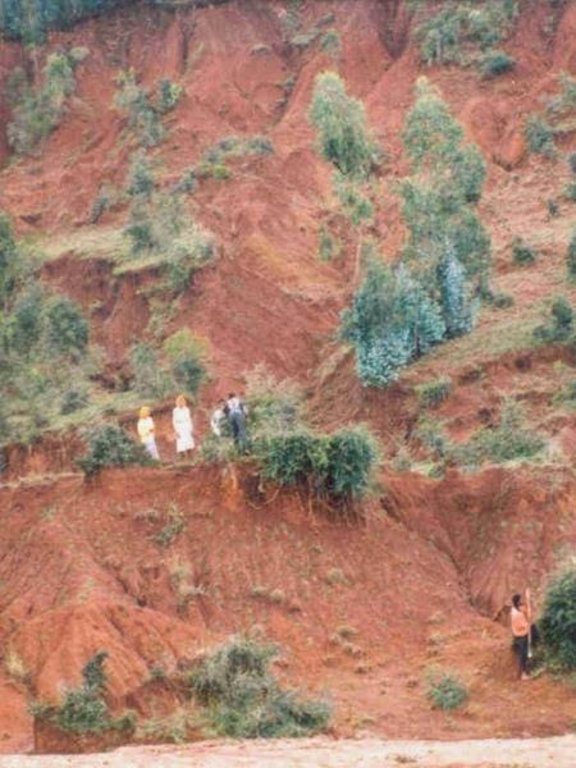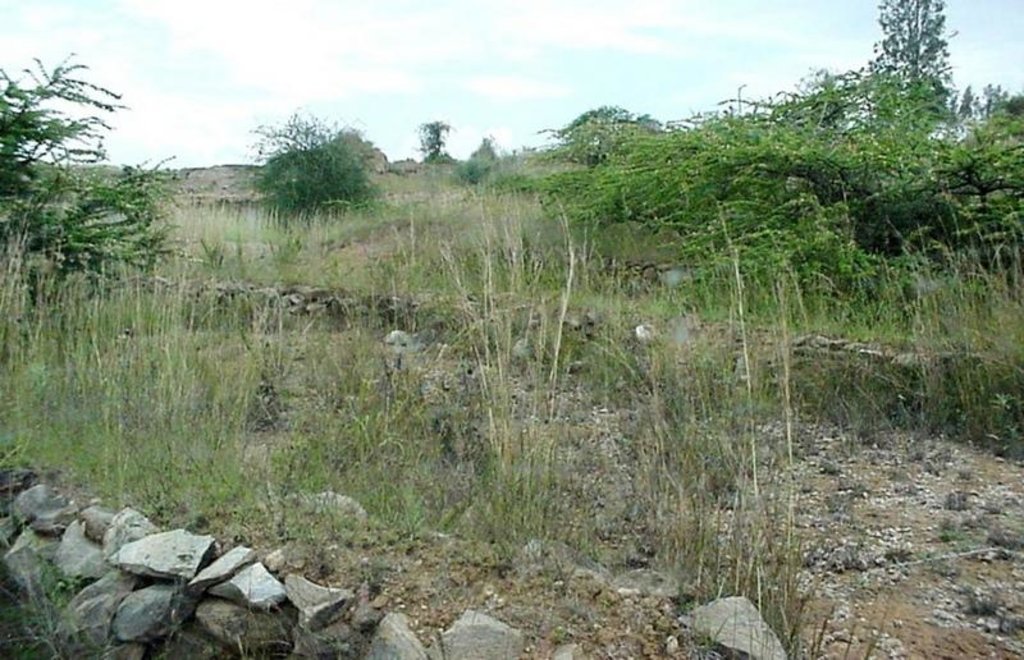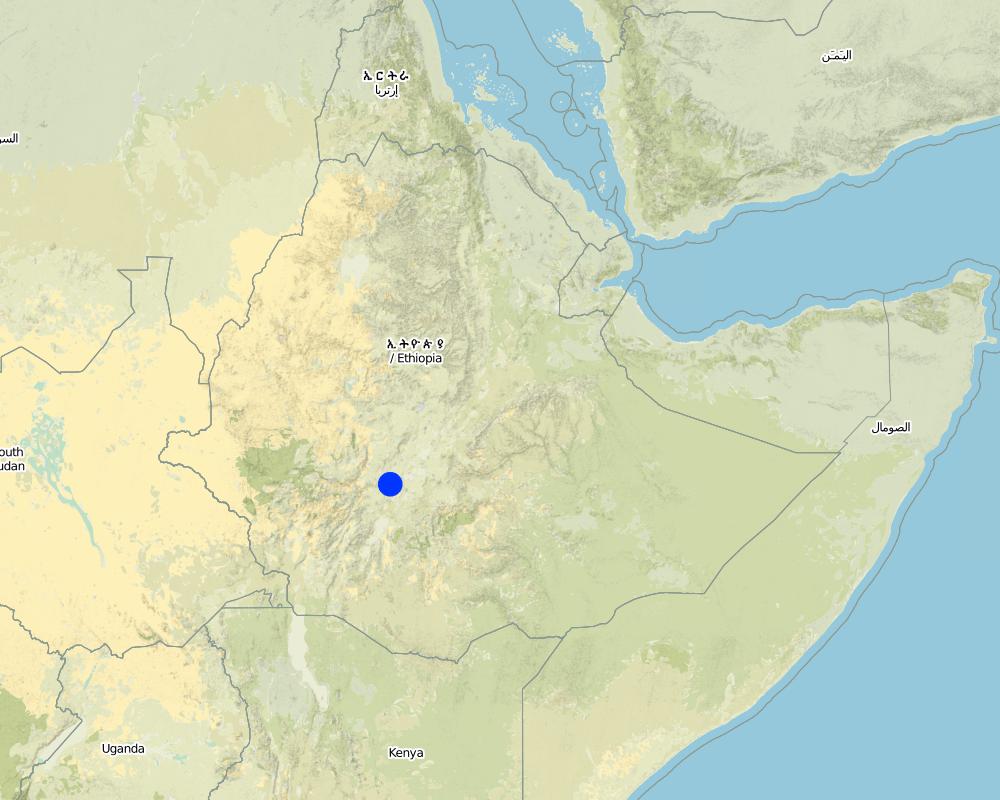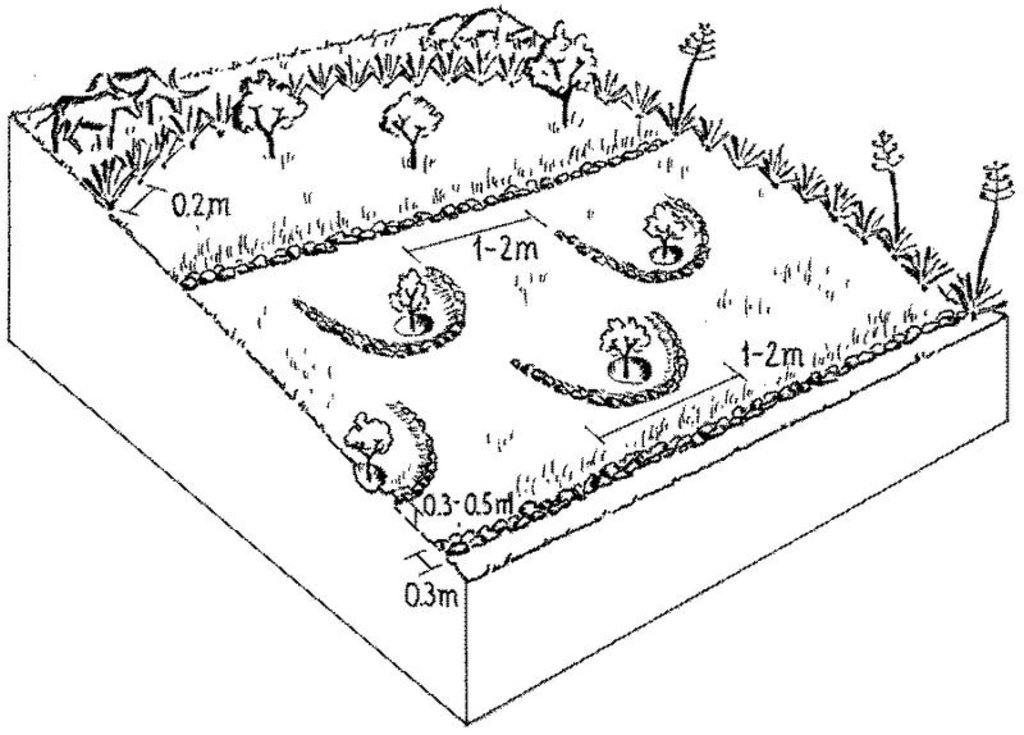Area closure for rehabilitation [เอธิโอเปีย]
- ผู้สร้างสรรค์:
- การอัพเดท:
- ผู้รวบรวม: Daniel Danano
- ผู้เรียบเรียง: –
- ผู้ตรวจสอบ: Fabian Ottiger, Donia Mühlematter
Meret mekelel
technologies_1048 - เอธิโอเปีย
ดูส่วนย่อย
ขยายทั้งหมด ย่อทั้งหมด1. ข้อมูลทั่วไป
1.2 รายละเอียดที่ติดต่อได้ของผู้รวบรวมและองค์กรที่เกี่ยวข้องในการประเมินและการจัดเตรียมทำเอกสารของเทคโนโลยี
ชื่อของโครงการซึ่งอำนวยความสะดวกในการทำเอกสารหรือการประเมินเทคโนโลยี (ถ้าเกี่ยวข้อง)
Book project: where the land is greener - Case Studies and Analysis of Soil and Water Conservation Initiatives Worldwide (where the land is greener)ชื่อขององค์กรซึ่งอำนวยความสะดวกในการทำเอกสารหรือการประเมินเทคโนโลยี (ถ้าเกี่ยวข้อง)
Ministry of Agriculture and Rural Development of Ethiopia (Ministry of Agriculture and Rural Development) - เอธิโอเปีย1.3 เงื่อนไขการใช้ข้อมูลที่ได้บันทึกผ่านทาง WOCAT
วันที่เก็บรวบรวมข้อมูล(ภาคสนาม) :
01/07/2003
ผู้รวบรวมและวิทยากรหลักยอมรับเงื่อนไขเกี่ยวกับการใช้ข้อมูลที่ถูกบันทึกผ่านทาง WOCAT:
ใช่
1.4 การเปิดเผยเรื่องความยั่งยืนของเทคโนโลยีที่ได้อธิบายไว้
เทคโนโลยีที่ได้อธิบายไว้นี้เป็นปัญหาของความเสื่อมโทรมโทรมของที่ดินหรือไม่ จึงไม่ได้รับการยอมรับว่าเป็นเทคโนโลยีเพื่อการจัดการที่ดินอย่างยั่งยืน:
ไม่ใช่
2. การอธิบายลักษณะของเทคโนโลยี SLM
2.1 การอธิบายแบบสั้น ๆ ของเทคโนโลยี
คำจำกัดความของเทคโนโลยี:
Enclosing and protecting an area of degraded land from human use and animal interference, to permit natural rehabilitation, enhanced by additional vegetative and structural conservation measures.
2.2 การอธิบายแบบละเอียดของเทคโนโลยี
คำอธิบาย:
Area closure involves the protection and resting of severely degraded land to restore its productive capacity. There are two major types of area enclosures practised in Ethiopia: (1) the most common type involves closing of an area from livestock and people so that natural regeneration of the vegetation can take place; (2) the second option comprises closing off degraded land while simultaneously implementing additional measures such as planting of seedlings, mulching and establishing water harvesting structures to enhance and speed up the regeneration process. The focus of this case study is on this second type.
The selection of measures chosen for rehabilitation depends mainly on the land use type, and to a lesser extent on climate, topography and soil type. Degraded croplands with individual land use rights are normally treated with additional structural measures to retain soil moisture and trap sediment, and with agronomic measures to restore soil fertility. Open access grazing lands are closed for natural regeneration while partly treated with additional measures, and open access woodlands are simply closed. In the case study area 60% of the enclosed area is under treatment with additional conservation measures and 40% is under natural regeneration. First, the area to be closed is demarcated and protected with fencing, usually live fences, and a site guard may be assigned to further ensure protection. Structural measures such as micro-basins, trenches, and bunds that enhance water infiltration and soil moisture may be constructed to increase survival rate of vegetative material planted. Hillside terraces, spaced at a 1 m vertical interval with a width of 1 m are constructed on steep slopes (exceeding 20%). Nitrogen-fixing and multipurpose shrubs/trees (for fodder, fuel) such as Acacia saligna, Sesbania sesban, Leucaena leucocephala as well as local grass species such as napier (Pennisetum purpureum) and rhodes (Chloris gayana) are planted as additional measures for conservation.
The maintenance of area enclosures involves activities such as replanting, maintaining of fences, pruning of trees and weeding. After one year, cut-and-carry of grass for stall-feeding can be partly practiced - which is of economic benefit to the farmers. Rehabilitation normally takes about 7-10 years depending on the level of degradation and intensity of management. Land use is limited to selective cutting of trees, collection of dead wood and cut-and-carry of grass for livestock fodder. On individually owned enclosures land users start cutting trees after three years (for eucalyptus) and after 7–8 years (for other trees), while on communal land farmers are allowed to collect dead wood after 3-–4 years, and the community decides about the use of trees.
2.3 รูปภาพของเทคโนโลยี
2.5 ประเทศภูมิภาค หรือสถานที่ตั้งที่เทคโนโลยีได้นำไปใช้และได้รับการครอบคลุมโดยการประเมินนี้
ประเทศ:
เอธิโอเปีย
ภูมิภาค/รัฐ/จังหวัด:
Alaba, South Ethiopia
ข้อมูลจำเพาะเพิ่มเติมของสถานที่ตั้ง :
Bilate River Catchment (Rift Valley)
Map
×2.7 คำแนะนำของเทคโนโลยี
ให้ระบุว่าเทคโนโลยีถูกแนะนำเข้ามาอย่างไร:
- ทางโครงการหรือจากภายนอก
3. การจัดประเภทของเทคโนโลยี SLM
3.1 วัตถุประสงค์หลักของเทคโนโลยี
- ปรับปรุงการผลิตให้ดีขึ้น
- ลด ป้องกัน ฟื้นฟู การเสื่อมโทรมของที่ดิน
- อนุรักษ์ระบบนิเวศน์
3.2 ประเภทของการใช้ที่ดินในปัจจุบันที่ได้นำเทคโนโลยีไปใช้

การใช้ที่ดินแบบผสมผสาน (รวมถึงวนเกษตร)
- ปศุสัตว์ร่วมกับการทำป่าไม้ (Silvo-pastoralism)
แสดงความคิดเห็น:
Major land use problems (compiler’s opinion): Over 30% of the land in the study area is degraded, resulting in low crop yields and poor livestock production. Severe water erosion is the main cause of land degradation on all slopes, followed by fertility depletion due to intensive cultivation practices and overgrazing. Serious gully formation and a high sediment load in the Bilate River threaten Lake Abaya. Communal grazing lands, woodlands with open access, and cultivated lands on steep slopes without conservation measures are particularly affected. By tradition, land users in rural Ethiopia can own as many livestock as they wish, which encourages overstocking.
Ranching: (before SWC)
Other grazingland: mixed silvo-pastoral (after SWC): cut-and-carry, trees
3.3 ข้อมูลเพิ่มเติมเกี่ยวกับการใช้ที่ดิน
การใช้น้ำของที่ดินที่มีการใช้เทคโนโลยีอยู่:
- จากน้ำฝน
ระบุ:
Longest growing period in days: 120 Longest growing period from month to month: Jun - Sep
3.4 กลุ่ม SLM ที่ตรงกับเทคโนโลยีนี้
- การปิดล้อมพื้นที่ (หยุดการใช้ประโยชน์ สนับสนุนการฟื้นฟู)
- มาตรการปลูกพืชขวางความลาดชัน (cross-slope measure)
3.5 กระจายตัวของเทคโนโลยี
แสดงความคิดเห็น:
Total area covered by the SLM Technology is 20 m2.
3.6 มาตรการ SLM ที่ประกอบกันเป็นเทคโนโลยี
3.7 รูปแบบหลักของการเสื่อมโทรมของที่ดินที่ได้รับการแก้ไขโดยเทคโนโลยี

การกัดกร่อนของดินโดยน้ำ
- Wt (Loss of topsoil): การสูญเสียดินชั้นบนหรือการกัดกร่อนที่ผิวดิน
- Wg (Gully erosion): การกัดกร่อนแบบร่องธารหรือการทำให้เกิดร่องน้ำเซาะ
- Wo (Offsite degradation): ผลกระทบนอกพื้นที่

การเสื่อมโทรมของดินทางด้านเคมี
- Cn (Fertility decline): ความอุดมสมบูรณ์และปริมาณอินทรียวัตถุในดินถูกทำให้ลดลงไป (ไม่ได้เกิดจากสาเหตุการกัดกร่อน)

การเสื่อมโทรมของดินทางด้านชีวภาพ
- Bc (Reduction of vegetation cover): การลดลงของจำนวนพืชที่ปกคลุมดิน
- Bs (Quality and species composition): องค์ประกอบหรือความหลากหลายทางคุณภาพและชนิดพันธุ์ลดลง
แสดงความคิดเห็น:
Main type of degradation addressed: Wt: loss of topsoil / surface erosion, Wg: gully erosion / gullying, Wo: offsite degradation effects, Cn: fertility decline and reduced organic matter content, Bc: reduction of vegetation cover, Bs: quality and species composition /diversity decline
3.8 การป้องกัน การลดลง หรือการฟื้นฟูความเสื่อมโทรมของที่ดิน
ระบุเป้าหมายของเทคโนโลยีกับความเสื่อมโทรมของที่ดิน:
- ฟื้นฟูบำบัดที่ดินที่เสื่อมโทรมลงอย่างมาก
4. ข้อมูลจำเพาะด้านเทคนิค กิจกรรมการนำไปปฏิบัติใช้ ปัจจัยนำเข้า และค่าใช้จ่าย
4.1 แบบแปลนทางเทคนิคของเทคโนโลยี
4.2 ข้อมูลจำเพาะด้านเทคนิคและการอธิบายแบบแปลนทางเทคนิค
Rehabilitation of degraded land based on enclosure with live fence. Natural regeneration of vegetative cover is supported by water harvesting structures and planting of nitrogen-fixing/multipurpose shrubs and trees as well as local grass species. On steeper slopes hillside terraces may be established.
Technical knowledge required for field staff / advisors: moderate
Technical knowledge required for land users: moderate
Main technical functions: improvement of ground cover, increase of infiltration, control of dispersed runoff, control of concentrated runoff, increase in soil fertility
Secondary technical functions: increase / maintain water stored in soil, less sediment deportation
Mulching
Material/ species: tree leaves/grass
Scattered / dispersed
Vegetative material: T : trees / shrubs
Vegetative measure: oversowing grasses
Vegetative material: G : grass
Vegetative measure: Vegetative material: G : grass
Vegetative measure: Vegetative material: G : grass
Vegetative measure: Vegetative material: G : grass
Trees/ shrubs species: Acacia saligna, Sesbania sesban, Leucaena leucocephala, Eucalyptus spp., Grevillea robusta
Grass species: nepier (Pennisetum purpureum), rhodes (Chloris gayana)
Structural measure: micro-basins (opt.)
Structural measure: terraces (opt.)
Structural measure: bunds (opt.)
Other type of management: land use change, enclosure,, cut-and-carry
4.4 กิจกรรมเพื่อการจัดตั้ง
| กิจกรรม | ประเภทของมาตรการ | ช่วงเวลาดำเนินการ | |
|---|---|---|---|
| 1. | Planting of trees (Eucalyptus spp., Grevillea robusta) as well as | ด้วยวิธีพืช | (early rainy season). |
| 2. | Oversowing/interplanting with local grass species: napier grass | ด้วยวิธีพืช | (early rainy season). |
| 3. | Marking the boundary and establishment of live fences: digging pits | ด้วยโครงสร้าง | early rainy season (before June). |
| 4. | Construction of structural measures such as micro- basins, trenches, bunds or hillside terraces. | ด้วยโครงสร้าง | before rains |
4.5 ค่าใช้จ่ายของปัจจัยนำเข้าที่จำเป็นสำหรับการจัดตั้ง
| ปัจจัยนำเข้า | หน่วย | ปริมาณ | ค่าใช้จ่ายต่อหน่วย | ค่าใช้จ่ายทั้งหมดต่อปัจจัยนำเข้า | %ของค่าใช้จ่ายที่ก่อให้เกิดขึ้นโดยผู้ใช้ที่ดิน | |
|---|---|---|---|---|---|---|
| แรงงาน | Labour | ha | 1.0 | 175.0 | 175.0 | 50.0 |
| อุปกรณ์ | Tools | ha | 1.0 | 25.0 | 25.0 | 100.0 |
| วัสดุด้านพืช | Seeds | ha | 1.0 | 40.0 | 40.0 | |
| วัสดุด้านพืช | Seedlings | ha | 1.0 | 150.0 | 150.0 | |
| วัสดุสำหรับก่อสร้าง | Stone | ha | 1.0 | |||
| วัสดุสำหรับก่อสร้าง | Wood | ha | 1.0 | |||
| อื่น ๆ | site guard (kg grain/ha/year) | ha | 1.0 | 1.0 | 1.0 | 100.0 |
| ค่าใช้จ่ายทั้งหมดของการจัดตั้งเทคโนโลยี | 391.0 | |||||
แสดงความคิดเห็น:
Duration of establishment phase: 2 month(s)
4.6 การบำรุงรักษาสภาพหรือกิจกรรมที่เกิดขึ้นเป็นประจำ
| กิจกรรม | ประเภทของมาตรการ | ช่วงระยะเวลา/ความถี่ | |
|---|---|---|---|
| 1. | Mulching with tree leaves/grass around newly planted trees, before | จัดการพืช | before rains / initial establishment |
| 2. | Replanting/gapping up live fence and trees during rains in the early | ด้วยวิธีพืช | during rains / |
| 3. | Harvesting grass | ด้วยวิธีพืช | during rainy season. / |
| 4. | Pruning of trees | ด้วยวิธีพืช | in the dry season. / |
| 5. | Weeding | ด้วยวิธีพืช | after rains. / |
| 6. | Repairing breaks in structures | ด้วยโครงสร้าง | before rains./ |
4.7 ค่าใช้จ่ายของปัจจัยนำเข้าและกิจกรรมที่เกิดขึ้นเป็นประจำที่ต้องการการบำรุงรักษา (ต่อปี)
| ปัจจัยนำเข้า | หน่วย | ปริมาณ | ค่าใช้จ่ายต่อหน่วย | ค่าใช้จ่ายทั้งหมดต่อปัจจัยนำเข้า | %ของค่าใช้จ่ายที่ก่อให้เกิดขึ้นโดยผู้ใช้ที่ดิน | |
|---|---|---|---|---|---|---|
| แรงงาน | Labour | ha | 1.0 | 35.0 | 35.0 | 100.0 |
| อุปกรณ์ | Tools | ha | 1.0 | 5.0 | 5.0 | 100.0 |
| วัสดุด้านพืช | Seeds | ha | 1.0 | 10.0 | 10.0 | |
| วัสดุด้านพืช | Seedlings | ha | 1.0 | 40.0 | 40.0 | |
| อื่น ๆ | site guard (kg grain/ha/year) | ha | 1.0 | 1.0 | 1.0 | 100.0 |
| ค่าใช้จ่ายทั้งหมดของการบำรุงรักษาสภาพเทคโนโลยี | 91.0 | |||||
แสดงความคิดเห็น:
Labour for establishment activities: 250 person days per ha for structural measures and planting of trees, plus guarding. Labour for maintenance: 50 person days for replanting/weeding. A common daily wage is US$ 0.70 (= 6 Ethiopian Birr), however in this case the site guards were given 3 kg of grains per ha per year. They can control over 200 ha.
5. สิ่งแวดล้อมทางธรรมชาติและของมนุษย์
5.1 ภูมิอากาศ
ฝนประจำปี
- < 250 ม.ม.
- 251-500 ม.ม.
- 501-750 ม.ม.
- 751-1,000 ม.ม.
- 1,001-1,500 ม.ม.
- 1,501-2,000 ม.ม.
- 2,001-3,000 ม.ม.
- 3,001-4,000 ม.ม.
- > 4,000 ม.ม.
ข้อมูลจำเพาะ/ความคิดเห็นเรื่องปริมาณน้ำฝน:
751-1,000 mm (ranked 1)
1,001-1,500 mm (ranked 2)
เขตภูมิอากาศเกษตร
- กึ่งชุ่มชื้น
Thermal climate class: tropics
5.2 สภาพภูมิประเทศ
ค่าเฉลี่ยความลาดชัน:
- ราบเรียบ (0-2%)
- ลาดที่ไม่ชัน (3-5%)
- ปานกลาง (6-10%)
- เป็นลูกคลื่น (11-15%)
- เป็นเนิน (16-30%)
- ชัน (31-60%)
- ชันมาก (>60%)
ธรณีสัณฐาน:
- ที่ราบสูง/ที่ราบ
- สันเขา
- ไหล่เขา
- ไหล่เนินเขา
- ตีนเนิน
- หุบเขา
ระดับความสูง:
- 0-100 เมตร
- 101-500 เมตร
- 501-1,000 เมตร
- 1,001-1,500 เมตร
- 1,501-2,000 เมตร
- 2,001-2,500 เมตร
- 2,501-3,000 เมตร
- 3,001-4,000 เมตร
- > 4,000 เมตร
ความคิดเห็นและข้อมูลจำเพาะเพิ่มเติมเรื่องสภาพภูมิประเทศ:
Altitudinal zone: Also 1,001-1,500 m a.s.l. (ranked 2) and 2001-2500 m a.s.l. (ranked 3)
Slopes on average: Also hilly (ranked 2) and moderate (ranked 3)
5.3 ดิน
ค่าเฉลี่ยความลึกของดิน:
- ตื้นมาก (0-20 ซ.ม.)
- ตื้น (21-50 ซ.ม.)
- ลึกปานกลาง (51-80 ซ.ม.)
- ลึก (81-120 ซ.ม.)
- ลึกมาก (>120 ซ.ม.)
เนื้อดิน (ดินชั้นบน):
- หยาบ/เบา (ดินทราย)
- ปานกลาง (ดินร่วน ทรายแป้ง)
อินทรียวัตถุในดิน:
- ต่ำ (<1%)
(ถ้ามี) ให้แนบคำอธิบายเรื่องดินแบบเต็มหรือระบุข้อมูลที่มีอยู่ เช่น ชนิดของดิน ค่า pH ของดินหรือความเป็นกรดของดิน ความสามารถในการแลกเปลี่ยนประจุบวก ไนโตรเจน ความเค็ม เป็นต้น:
Soil depth on average: Also moderately deep (ranked 2) and deep (ranked 3)
Soil fertility: Low
Topsoil organic matter: Also medium and high (both ranked 2)
Soil drainage/infiltration: Good
Soil water storage capacity: Very high
5.6 ลักษณะของผู้ใช้ที่ดินที่นำเทคโนโลยีไปปฏิบัติใช้
แนวทางการตลาดของระบบการผลิต:
- เพื่อการยังชีพ (หาเลี้ยงตนเอง)
รายได้ที่มาจากนอกฟาร์ม:
- < 10% ของรายได้ทั้งหมด
ระบุลักษณะอื่นๆที่เกี่ยวข้องของผู้ใช้ที่ดิน:
Off-farm income specification: from petty trade, weaving, etc
5.7 พื้นที่เฉลี่ยของที่ดินที่เป็นเจ้าของหรือเช่าโดยผู้ใช้ที่ดินที่นำเทคโนโลยีไปปฏิบัติใช้
- < 0.5 เฮกตาร์
- 0.5-1 เฮกตาร์
- 1-2 เฮกตาร์
- 2-5 เฮกตาร์
- 5-15 เฮกตาร์
- 15-50 เฮกตาร์
- 50-100 เฮกตาร์
- 100-500 เฮกตาร์
- 500-1,000 เฮกตาร์
- 1,000-10,000 เฮกตาร์
- >10,000 เฮกตาร์
5.8 กรรมสิทธิ์ในที่ดิน สิทธิในการใช้ที่ดินและสิทธิในการใช้น้ำ
กรรมสิทธิ์ในที่ดิน:
- รัฐ
สิทธิในการใช้ที่ดิน:
- เข้าถึงได้แบบเปิด (ไม่ได้จัดระเบียบ)
- รายบุคคล
6. ผลกระทบและสรุปคำบอกกล่าว
6.1 ผลกระทบในพื้นที่ดำเนินการ (On-site) จากการใช้เทคโนโลยี
ผลกระทบทางด้านเศรษฐกิจและสังคม
การผลิต
การผลิตพืชที่ใช้เลี้ยงปศุสัตว์
แสดงความคิดเห็น/ระบุ:
(cut-and-carry of grass)
คุณภาพพืชที่ใช้เลี้ยงปศุสัตว์
แสดงความคิดเห็น/ระบุ:
(cut-and-carry of grass)
การผลิตไม้
พื้นที่สำหรับการผลิต
แสดงความคิดเห็น/ระบุ:
Reduction of grazing area leads to high pressure on remaining grazing areas
รายได้และค่าใช้จ่าย
ค่าใช่จ่ายของปัจจัยการผลิตทางการเกษตร
รายได้จากฟาร์ม
แสดงความคิดเห็น/ระบุ:
(selling grass/wood)
ภาระงาน
ผลกระทบด้านสังคมวัฒนธรรมอื่น ๆ
สถาบันของชุมชน
SLM หรือความรู้เรื่องความเสื่อมโทรมของที่ดิน
การบรรเทาความขัดแย้ง
แสดงความคิดเห็น/ระบุ:
Unequal share of benefits, some illegal cutting of vegetation is involved
ผลกระทบด้านนิเวศวิทยา
วัฐจักรน้ำหรือน้ำบ่า
การระบายน้ำส่วนเกิน
ดิน
ความชื้นในดิน
แสดงความคิดเห็น/ระบุ:
>50%
สิ่งปกคลุมดิน
แสดงความคิดเห็น/ระบุ:
>80%
การสูญเสียดิน
แสดงความคิดเห็น/ระบุ:
initially 50% reduction, after 2–3 years
ผลกระทบด้านนิเวศวิทยาอื่น ๆ
Soil fertility
แสดงความคิดเห็น/ระบุ:
increased organic matter, nitrogen fixing shrubs
Biodiversity
แสดงความคิดเห็น/ระบุ:
recovering disappearing local species
competition between (grass)species
แสดงความคิดเห็น/ระบุ:
competition between naturally regenerating and oversown (grass)species
6.2 ผลกระทบนอกพื้นที่ดำเนินการ (Off-site) จากการใช้เทคโนโลยี
การไหลของน้ำคงที่และสม่ำเสมอในช่วงฤดูแล้ง
แสดงความคิดเห็น/ระบุ:
Also groundwater recharge
น้ำท่วมพื้นที่ท้ายน้ำ
การทับถมของดินตะกอนพื้นที่ท้ายน้ำ
แสดงความคิดเห็น/ระบุ:
Less sediment transported
การเกิดมลพิษในน้ำบาดาลหรือแม่น้ำ
6.4 การวิเคราะห์ค่าใช้จ่ายและผลประโยชน์ที่ได้รับ
ผลประโยชน์ที่ได้รับเปรียบเทียบกับค่าใช้จ่ายในการจัดตั้งเป็นอย่างไร (จากมุมมองของผู้ใช้ที่ดิน)
ผลตอบแทนระยะสั้น:
ด้านบวก
ผลตอบแทนระยะยาว:
ด้านบวกอย่างมาก
ผลประโยชน์ที่ได้รับเปรียบเทียบกับค่าใช้จ่ายในการบำรุงรักษาหรือต้นทุนที่เกิดขึ้นซ้ำอีก เป็นอย่างไร (จากมุมมองของผู้ใช้ที่ดิน)
ผลตอบแทนระยะสั้น:
ด้านบวก
ผลตอบแทนระยะยาว:
ด้านบวกอย่างมาก
6.5 การปรับตัวของเทคโนโลยี
จากทั้งหมดที่ได้รับเทคโนโลยีเข้ามามีจำนวนเท่าใดที่ทำแบบทันที โดยไม่ได้รับการจูงใจด้านวัสดุหรือการเงินใด ๆ:
- 90-100%
แสดงความคิดเห็น:
300 land user families have adopted the Technology with external material support
90% of land user families have adopted the Technology without any external material support
There is a moderate trend towards spontaneous adoption of the Technology
Comments on adoption trend: Adoption rate has considerably increased owing to improved ownership feeling and immense benefits obtained through the practice. However, if labour-intensive structural measures are required people rely on food-for-work incentives.
6.7 จุดแข็ง / ข้อได้เปรียบ / โอกาสของเทคโนโลยี
| จุดแข็ง / ข้อได้เปรียบ / โอกาสในทัศนคติของผู้รวบรวมหรือวิทยากรหลัก |
|---|
|
Reduction of on-site and off-site land degradation, reclamation of degraded non-productive land (regenerating fertility) How can they be sustained / enhanced? Strengthen maintenance and protection to increase biomass production of enclosure. |
|
Fodder shortage is reduced through cut-and-carry of grass in enclosures (after 1 year) How can they be sustained / enhanced? Introduce more productive and nutritious grass/legume species. |
|
Collection of dead wood from enclosures (after 3–4 years) mitigates fuelwood shortage How can they be sustained / enhanced? Introduce alternative fast growing multi-purpose tree species such as Grevillea robusta (fodder for smallstock in very dry periods). |
|
Cutting wood for construction of houses and wooden farm implements (after 7–8 years) How can they be sustained / enhanced? Continue planting of multipurpose trees. |
|
Increased honey production through increased bee activity in enclosures Emerge of springs, which have disappeared due to deforestation/land degradation Income generation: farmers sell grass/wood collected from area enclosures; they make profit despite seven years enclosure How can they be sustained / enhanced? Improve beehives, ‘bee feed’ (bee-friendly plants), and access to market. Maintain proper ground cover to improve infiltration and percolation of rainwater. Better management of planted grass, making of hay, improve market systems. |
|
Emergence of springs, which have disappeared due to deforestation/land degradation -> Maintain proper ground cover to improve infiltration and percolation of rainwater. - Income generation: farmers sell grass/wood collected from area enclosures; they make profit despite seven years enclosure -> Better management of planted grass, making of hay, improve market systems. Editors’ comments: Protecting degraded land against grazing is a common practice worldwide. In Ethiopia it is the second most important SWC practice after structural conservation measures. About 1.2 million hectares of degraded lands have been closed for rehabilitation in Ethiopia during the past three decades. As this case study shows, results are encouraging both in terms of effective protection and enhanced production. Land use rights: open access on woodlands and grazing lands (communal land use rights), individual on cropland |
6.8 จุดอ่อน / ข้อเสียเปรียบ / ความเสี่ยงของเทคโนโลยีและวิธีการแก้ไข
| จุดอ่อน / ข้อเสียเปรียบ / ความเสี่ยงในทัศนคติของผู้รวบรวมหรือวิทยากรหลัก | มีวิธีการแก้ไขได้อย่างไร |
|---|---|
| On highly eroded areas and in areas with low rainfall the survival rate of trees and shrubs is low and as a result the benefits only come after a very long period. This situation becomes unacceptable to the land users |
Select suitable local and exotic multipurpose tree/shrub species adapted to the local conditions (Acacia spp., Eucalyptus spp., Grevillea robusta etc). Construct water-harvesting structures (trenches, micro-basins). Raise awareness among land users through meetings and training. |
| Investment costs are rather high for land users | Credits, loans, cooperatives. |
| Inequitable share of benefits | Awareness should be increased through enhancing the LLPP approach. |
7. การอ้างอิงและการเชื่อมต่อ
7.2 การอ้างอิงถึงสิ่งตีพิมพ์
หัวข้อ, ผู้เขียน, ปี, หมายเลข ISBN:
Chadokar PA: Multipurpose Plant Species for Soil and Water Conservation. Assistance to Soil and Water ConservationProgramme. ETH/81/003. 1985.
หัวข้อ, ผู้เขียน, ปี, หมายเลข ISBN:
Betru Nedassa: Biological Soil Conservation Measures. Land Rehabilitation and Reforestation Project. Project 2488MOA/WFP. 1995.
ลิงก์และโมดูล
ขยายทั้งหมด ย่อทั้งหมดลิงก์
ไม่มีลิงก์
โมดูล
ไม่มีโมดูล


